There are so many rewards of dog training your dog when it’s done correctly. Dogs are one of the most beloved critters around the world. It’s no wonder why so many individuals and families decide to adopt a dog of their own!
Learning about dog training is an absolute must for new owners. Training helps your dog feel happier and more secure in their new environment. This, in turn, results in a much more well-behaved pup. The Leash Team offers private dog training and private puppy training if you get stuck with any aspect of your dog’s behaviours.
If you’re wanting to get started on your own we’ve provided a comprehensive overview of the essentials of training a dog that you can get started on right away. From potty and obedience training to socialization, this guide has you covered! Don’t forget, we’re here to help. Reach out and we’ll get you and your pooch going in the right direction if you have any problems or concerns.
Getting Started: How to Successfully Train Your Dog
Bringing a new pet into your life is an exciting time! It also means you will need to get serious about establishing a training schedule.
There are three key elements to successfully training your dog:
-
Consistency: Whether it’s the words you use as commands or the rules you set in the house, consistency is key. Dogs need lots of repetition and uniformity when learning new lessons!
-
Routine: Going hand-in-hand with consistency is a recurring routine. A good routine consists of keeping the same schedule of eating, walking, and training. Plus, it helps set your dog's daily expectations and can keep them feeling happier.
-
Patience: Training takes time! You can’t expect your dog to become a behavioral superstar overnight. Being patient and observant of your dog and their needs is crucial.
In this article, we will be covering the following 7 phases of dog training:
-
Housebreaking and Crate Training
-
Teaching Recall: the Come Command
-
The 4 Basic Dog Commands (Sit, Stay, Lie Down, Leave It)
-
Leash Training
-
Socialization
-
Whistle Training
-
Proofing
Plus, we will discuss when and why to consider getting help from a professional trainer!
House and Crate Training: Bringing Your New Pup or Mature Dog Home
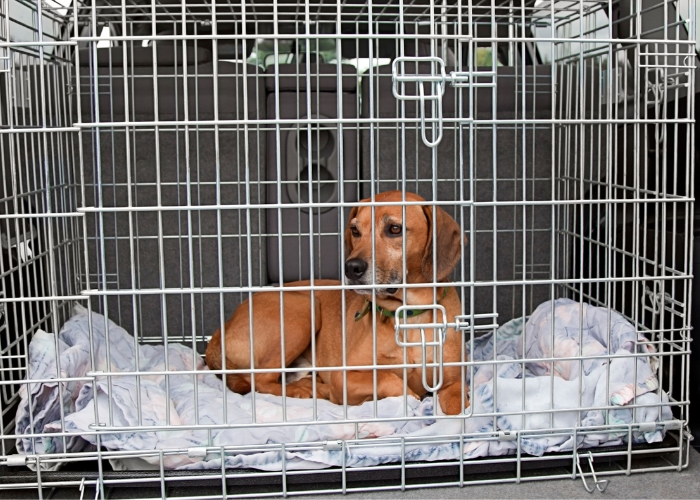
Once you have brought your new pup home, housebreaking and crate training them should be your first priority. These lessons help your dog to feel more comfortable and aid in setting immediate boundaries in your home.
There are a few key differences between teaching these lessons to puppies versus to adults, which we will help to uncover as well in this section.
Housebreaking and Potty Training

Housebreaking, also known as potty training, is the process of teaching your dog not to go to the bathroom in the house. This is an important step, as no one wants dog excrements or odors in their home!
There are 4 key elements to housebreaking a dog:
-
Creating a Schedule: When you walk your dog at the same times every day, they learn to expect when they get to go outside. This results in dogs learning to hold their bladder until their scheduled walk time.
-
Choosing a Training Method: Introducing crate or paper training is essential for housebreaking a dog. Oftentimes, owners may choose to use a combination of the two. Keep reading below for a more in-depth explanation of crate and paper training.
-
Controlling the Diet: When and how much a dog eats and drinks has a major impact on how often they need to go out. Keeping their diet on a regular schedule will help to keep their necessary bathroom breaks regular as well.
-
Observing Behavior: Dogs will naturally display signs of needing to go out. Learning and watching for these signs is key for housebreaking. These signs typically include pacing near the door, whining, squatting, and restlessness.
When it comes to choosing between crate and paper training, it is important to examine the purpose of each.
Paper Training
Paper training is often used for puppies since they have weaker bladders and are more likely to go in the house. However, it is also useful for adult dogs who are not housebroken or have bladder problems.
Paper training consists of the following steps:
-
Owners place puppy pads or other absorbent sheets of material on the floor.
-
When the puppy begins to go inside the house, they are quickly picked up and moved onto a pad.
-
The pad is then removed from the floor and replaced with a new one. Replacing pads each time will cut back on odors in the house.
-
This process is then repeated until the puppy goes to the pad on its own. When they do, they should receive rewards for doing so.
It is important to note that paper training is a solution for when puppies or older dogs have weak bladders. For puppies, pads should be slowly phased out as their bodies mature and as they learn to go outside.
Crate Training
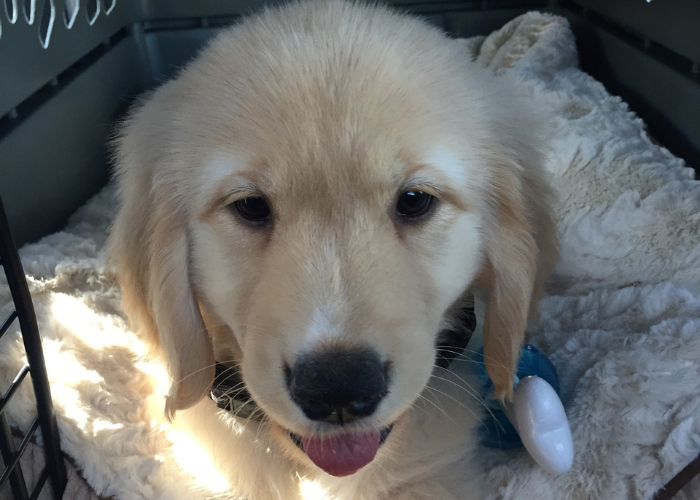
Crate training serves a multitude of purposes. Not only does it help with potty training, but it can boost your dog’s comfort levels and keep them from destroying household items.
First, an important note about crates:
A dog’s crate should feel like a home and be a source of comfort and security. This means that you should never use the crate as a form of punishment! The last thing you want is for your dog to become uneasy or fearful inside their crate.
Here is a quick breakdown of the main purposes of a crate:
-
Potty Training: By introducing a crate into your dog’s life, you are giving them a space that is their own. Making them sleep in the crate at night will encourage them to hold their bladder, as they will not want to dirty their space!
-
Safety Zone: Dogs need to feel secure. Stressors such as storms or strangers can make a dog feel uncomfortable or anxious. Having a crate set up and left open allows dogs to enter and exit their safe space as they please.
-
Home Alone Containment: Dogs get bored when they are home alone – and boredom can lead to chewing! Keeping a dog in their crate while you are away is essential for preventing your dog from causing damage and destruction in the home.
Choosing a Crate
The biggest consideration when choosing a dog crate is the size.
Your dog should be able to comfortably stand up without having to duck their head down while in the crate. The length and width of the crate should give them enough room to move around and lay down.
Most crates will include size information to help you determine which to purchase. Make sure to measure your dog’s height and length before buying a crate!
Introducing the Crate
A crate may be an entirely new object to some dogs, causing them to be uncertain at first. Older dogs may even already have negative impressions of crates!
To introduce them to the crate, you must first make the crate as homey as possible! Adding beds, blankets, and toys will make the crate more inviting to your dog. Then, you will need to use treats and verbal rewards to coax the dog into the crate. It is important to offer rewards both when the dog enters the crate and when they exit.
It is key during crate training to not reward whining. If your dog is whining, howling, or barking, do not let them out of the crate until they have settled down. Always take your dog out for a bathroom break before leaving them in the crate for an extended period!
Good Crate Habits to Build On
Crate training is the start of teaching your dog good and healthy habits. Some habits to build upon using crate training include:
-
The “Crate” Command: Using a directional command such as “crate” can help introduce your dog to the concept of responding to your words. This will help later on when teaching basic dog commands.
-
Chewing Toys: Keeping chewing toys in the crate will help your dog to begin associating their need to chew with their toys. This will aid in teaching your dog not to chew or destroy household objects or furniture.
-
Setting In-House Boundaries: Giving your dog their own space in the form of a crate is the first boundary you set. This helps you to later define additional boundaries, such as which areas of the house the dog is not permitted to enter.
Recall: Teaching Your Dog to Come When You Call Him
Recall is a skill used to teach dogs to come when you call. The reason this lesson is so important is you need your dog to listen to you in dire or emergencies. Teaching recall is also the first building block for teaching your dog to behave off-leash later on!
Here are 4 key tips for teaching recall to your dog:
-
Start with eye contact. Each time you give the recall command or say their name, reward them when they look at you. This teaches your dog the importance of paying attention when you speak.
-
Always deliver the command in a controlled, calm, and firm voice.
-
In the early stages of teaching recall, reward your dog each time they listen to the command. This includes times when it takes a while for them to respond. The goal is for your dog to have a positive association attached to listening to your commands.
-
Give your dog at least a month of daily practice to get the command memorized!
Basic Dog Commands: Start with These 4 Commands
Once you have recall down, it is time to move on to the four basic commands. The commands are sit, stay, lie down, and leave it. These are the building blocks to obedience training! An important element of teaching the basic commands is that you use force-free training methods.
Force-free dog training is a type of training that does not use physical corrections or punishments. This is to avoid inflicting pain, fear, or intimidation on the dog which may cause the dog to become aggressive or anxious later on.
Instead, we recommend using behavior modification methods that use positive reinforcement (treats, praise, clickers, etc.)
In this section, we will provide you with step-by-step breakdowns of how to teach each skill. These quick guides to teach the basic commands help with both puppy and adult obedience training!
Teaching Your Dog To Sit
Sit is a fundamental command to teach to your dog. The sitting position automatically puts dogs into a more calm and focused state. This command is also built on to achieve the commands “stay” and “lie down”!
Here are the 5 steps to teaching sit:
-
Use a treat to get your dog’s attention. Hold the treat in front of their nose, but do not let them eat it.
-
Once you have their attention, slowly lift the treat above their head and back towards their tail. As their eyes and head follow the treat, their rear end will naturally begin to lower.
-
When in the sitting position, praise them and give the treat as a reward. Repeat steps 1-3 until they begin to understand what you want without the luring.
-
As the dog begins to sit without the lure, start saying “sit” as they move into the position. Offer a reward for each successful sit.
-
Begin showing the treat without using it as a lure. Tell the dog “sit” and reward them when they obey.
Congrats, your dog knows how to sit! To ween them off of treats, begin alternating when they do and do not get treats for obeying. Replace the treat with verbal rewards and praise!
Teaching Your Dog To Stay
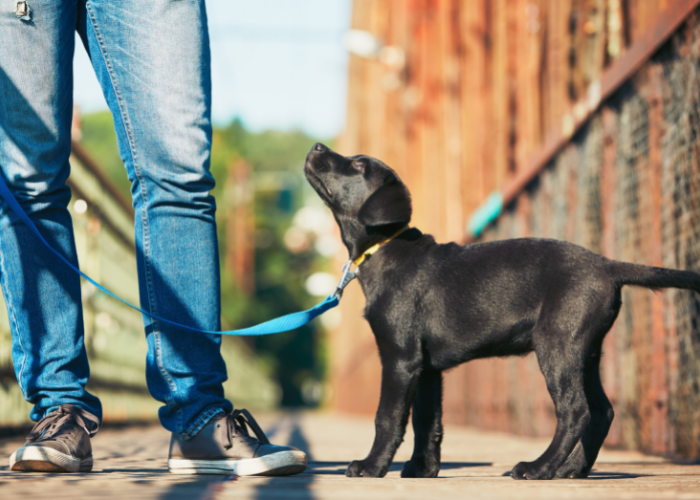
Stay is essentially a more advanced form of sit. Stay is a crucial command to master, as it will help you keep control of your dog when you are outside the home.
The steps for teaching stay are as follows:
-
Get your dog into either a sitting or lying position. Give them a visual alert that you want them to stop what they are doing, such as an open palm facing them.
-
Deliver the “stay” command.
-
After only a couple of seconds, reward your dog for maintaining the position. Learning to stay can be confusing, so starting with short holds and working up to longer ones is key.
-
Repeat steps 1-3, gradually increasing both the time you make the dog hold the position and your distance from the dog.
Teaching Your Dog To Lie Down
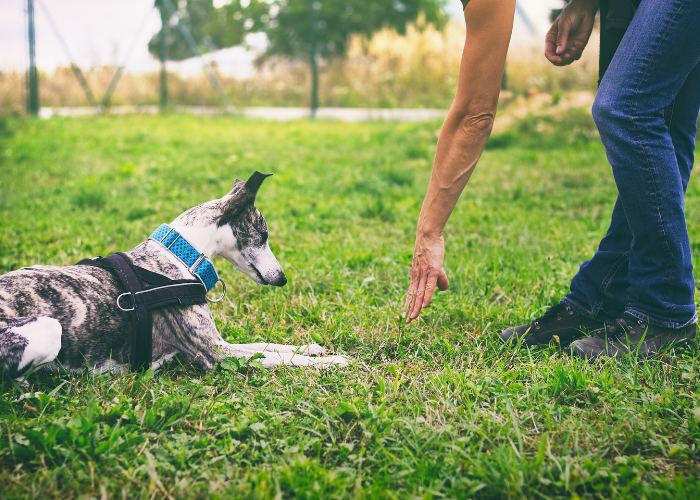
Teaching lie down allows you to control your dog’s excitement level and help them calm down in stressful situations. Some owners even prefer to teach stay from the laying position!
Teach your dog to lie down with these 3 easy steps:
-
From the sitting position, hold the treat in front of your dog’s nose.
-
Lure your dog to the floor by slowly moving the treat downwards. Reward and repeat until the dog begins to lie down without the lure.
-
Incorporate the “lie down” command as the dog moves into the position. Reward after each successful completion!
As with teaching sit, you can wean your dog off treats by slowly replacing treats with verbal praise!
Teaching Your Dog To Leave It
“Leave it” is crucial, especially when going outdoors with dogs where there are many objects that you do not want them picking up (like trash!). It teaches your dog to listen to you about what they can and can’t have.
Here are the 4 key steps to teaching leave it:
-
Place treats on the floor in front of your dog. As they go to eat them, firmly tell them “leave it.”
-
If they do not stop trying to eat the treats, pick the treats up off the ground. If they do wait (even if only for a second) reward them by giving them the treat. Repeat this until they begin to wait when you put the treats on the floor.
-
Once they have begun waiting, gradually increase the time you require them to “leave it” before giving them the treat.
And voila! You have taught your dog to leave it. Keep in mind that this command can be a bit tricky at first. Just remember, consistency and patience are key.
Leash Training
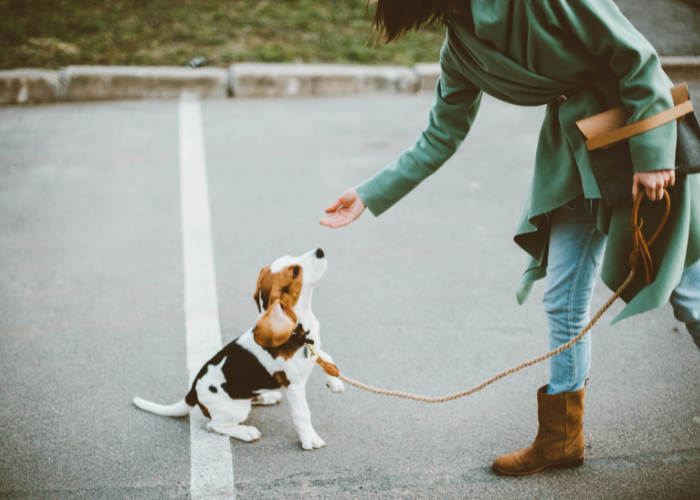
Leashes are indispensable when taking your dog outside – and oftentimes, required by law! Training your dog on a leash is not dissimilar to teaching the basic commands. It requires an emphasis on positive reinforcement and lots of repetition!
In this section, we will cover the types of leases to choose from and the basics of leash training.
The Types of Leashes
It is important when buying a leash to take your dog’s size, weight, and strength into consideration. Different leashes are made with various dogs in mind!
Here are the 3 main categories of leashes to consider using for your dog:
-
Flat Leads: Flat leads are the standard leash. They are typically made from nylon material and are somewhat stiff and inflexible. These leases are best for medium size dogs with moderate amounts of strength.
-
Rope and Bungee: Rope and bungee leashes are designed to handle more force and strain. They are also fairly durable. This makes them a good option for larger dogs, or dogs with a lot of upper body strength.
-
Retractable: Retractable leashes allow you to easily adjust the distance your dog is from you. They are not super powerful contraptions, making them most useful for small dogs.
Walking on a Leash
If your dog has mastered the basic commands, now is the time to put them into action. When walking your dog, it is okay for them to be curious about their surroundings. However, you ultimately want your dog to be attentive and ready to listen to you as well. Here are 4 tips for teaching your dog to walk on a leash:
-
The key to stopping your dog from pulling is to stop walking altogether. When they are pulling, get them into a sitting position and wait until they are ready to listen to you before re-starting your walk.
-
Use treats, clickers, and verbal praise to inform your dog they are doing what you want when not pulling.
-
As with teaching the basic commands, start with short periods of your dog not pulling and move up to longer periods gradually. Be sure to provide rewards as you move up in time!
-
Choose a command word for walking beside you. “Heel” is a commonly used command that instructs dogs to move to your side immediately.
Behaviors You Want to Discourage
When walking your dog on a leash, there are 4 main behaviors to avoid:
-
Pulling: Pulling is the most obvious and frustrating bad behavior on the leash. Tackling this issue through behavior modification is crucial!
-
Leading: Even with a loose leash, you should try to avoid allowing your dog to lead where you are going. You should always assume the role of the leader and have your dog walk beside you, not in front.
-
Ignoring: Allowing your dog to ignore you while walking is the foundation of bad leash behavior. If your dog is not responding to your commands, stop walking and regain their attention.
-
Greeting: When you encounter other people or animals, you should greet them before your dog. This teaches your dog that you are the protector and they do not need to be fearful of strangers.
Socializing
Socializing your dog is important for ensuring they know how to behave around other people and animals.
If you are adopting a mature dog, be sure to ask about their existing behavior around others. If they have pre-existing problems with aggression or anxiety, it may be best to seek help from a trainer for socialization.
For dogs or puppies without aggression or anxiety problems, here are 3 key tips for socialization:
-
Take walks in areas with lots of visitors, such as public parks. This helps your dog gain confidence in unfamiliar places with many strangers.
-
Have friends with dogs over for playdates. This is a good opportunity to create an intimate setting to monitor your dog’s behavior around both people and animals.
-
Dog parks can be overwhelming, especially for younger dogs. Get your basics down and build up your animal’s confidence before taking on the dog park!
Whistle Training
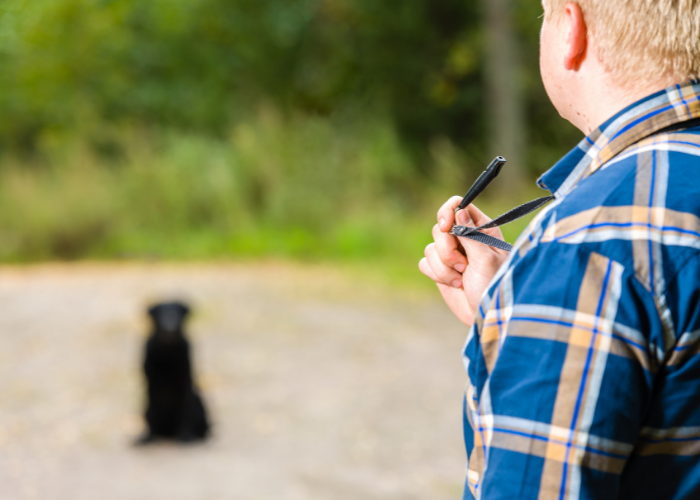
Whistle training can be used for many purposes, including:
Whistles are most commonly paired with recall training, especially when owners begin training their dog to be off-leash.
The key to using whistles is to not overcomplicate the association. Your dog can only associate so many things with one command and the whistling noise serves a singular command.
Thus, you should use the whistle for one primary purpose, such as recall training.
Proofing
Proofing is a process in dog training of ensuring your dog can follow commands in any environment.
There is a big difference between obedience at home and obedience in the outside world. At home, there are minimal distractions for your dog, and obedience yields high rewards. Comparatively, the outside world has all sorts of sounds, sights, and smells that cause your dog to lose focus.
To proof your dog’s behavior, simply follow your normal training routine in multiple locations throughout the week.
Remember to focus on improving the 3 Ds of proofing:
-
Distance: How far your dog can be from you and still obey
-
Duration: How long your dog can obey a specific command for
-
Distraction: How many distractions your dog can ignore while obeying
Seeking Professional Dog Training
The fact is that most dog owners are not training professionals. Every dog is unique and will respond to training differently. For some, they have more inherently anxious personalities that get in the way of proper training.
When adopting adult dogs especially, they may have lacked the right structure and training to give them confidence. Without it, they may have formed anxious or aggressive habits.
Here are 5 crucial reasons to consider seeking the help of a professional trainer:
-
Your dog has displayed aggression towards people or animals.
-
You are unable to make your dog obey commands no matter how hard you try.
-
You feel fearful or anxious about your dog’s behavior.
-
Your dog has too much energy and can’t focus easily.
-
You want help! There’s no shame in admitting that dog training can be hard and we all need a little help sometimes.
Final Thoughts
Dogs are valued members of our families. We give them heaps of our time and love to make sure they are happy and taken care of.
A key part of taking care of your dog is providing them with proper training. Dogs need both mental and physical stimulation and training can provide both!
If you are struggling with your dog’s training regiment, don’t be afraid to seek out help from professionals. At The Leash Team, we have several certified and professional dog trainers and behaviour modification experts that can help you with any aspect of your dog’s training.
As you embark on your journey with your new dog, remember the 3 key elements to training:
Consistency, routine, and patience!